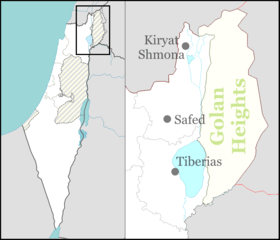Kfar Hoshen
Kfar Hoshen (Hebrew: כפר חושן), also known as Safsufa (ספסופה), is a moshav in northern Israel. Located around four kilometres north of Meron, it falls under the jurisdiction of Merom HaGalil Regional Council. In 2018 it had a population of 787.[1]
Kfar Hoshen כפר חושן | |
|---|---|
 Kfar Hoshen | |
| Coordinates: 33°0′44.39″N 35°26′29.36″E | |
| Country | Israel |
| District | Northern |
| Council | Merom HaGalil |
| Affiliation | Moshavim Movement |
| Founded | 1949 |
| Founded by | Bulgarian-Jewish immigrants |
| Population (2018)[1] | 787 |
History
The moshav was founded in 1949 by immigrants to Israel from Bulgaria and with the support of the Moshavim Movement. The land had previously belonged to the Palestinian village of Safsaf, whose residents fled to Lebanon after the Safsaf massacre in October 1948 during the 1948 Arab-Israeli war.[2][3] The population was added in early years of the state by Jewish immigrants from Yemen and Aden, and starting in 1953 immigrants from Morocco and Tunisia also came.
The original name "Safsufa" is based on an identical name found in the Talmud, whose name is preserved in the village Safsaf; the Hebrew word "Safsaf" means an area where fruits ripen later than usual.
The residents work in agriculture and tourism.
Notable residents
References
- "Population in the Localities 2018" (XLS). Israel Central Bureau of Statistics. 25 August 2019. Retrieved 26 August 2019.
- Morris, Benny (2004). The Birth of the Palestinian Refugee Problem Revisited. Cambridge: Cambridge University Press. p. xxi. ISBN 9780521009676.
- Khalidi, Walid (1992), All That Remains: The Palestinian Villages Occupied and Depopulated by Israel in 1948, Washington D.C.: Institute for Palestine Studies, p. 491, ISBN 0-88728-224-5